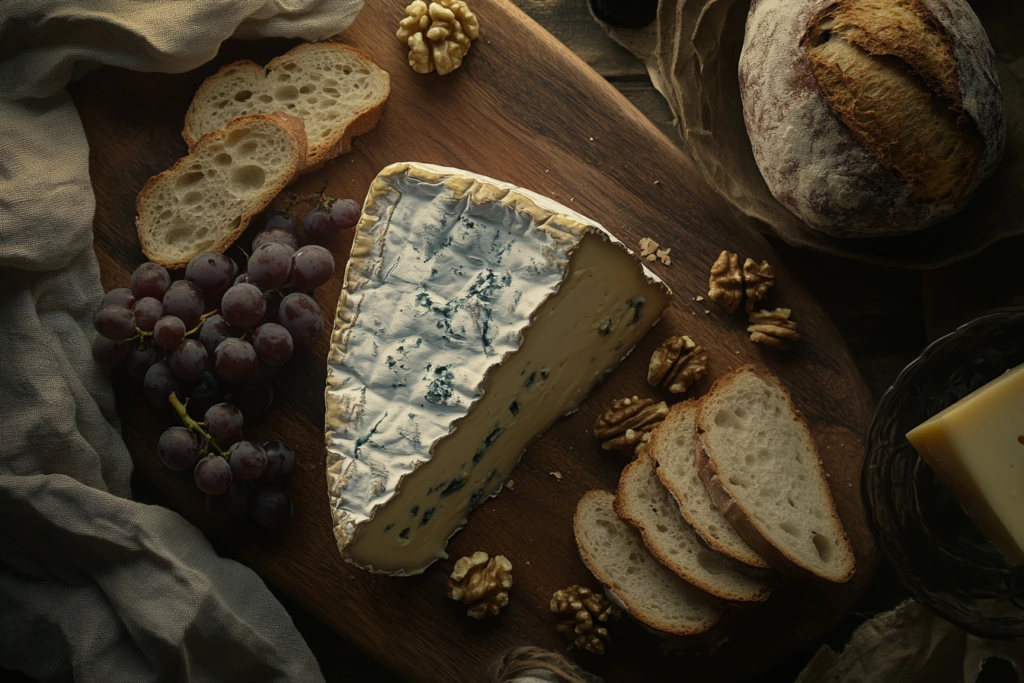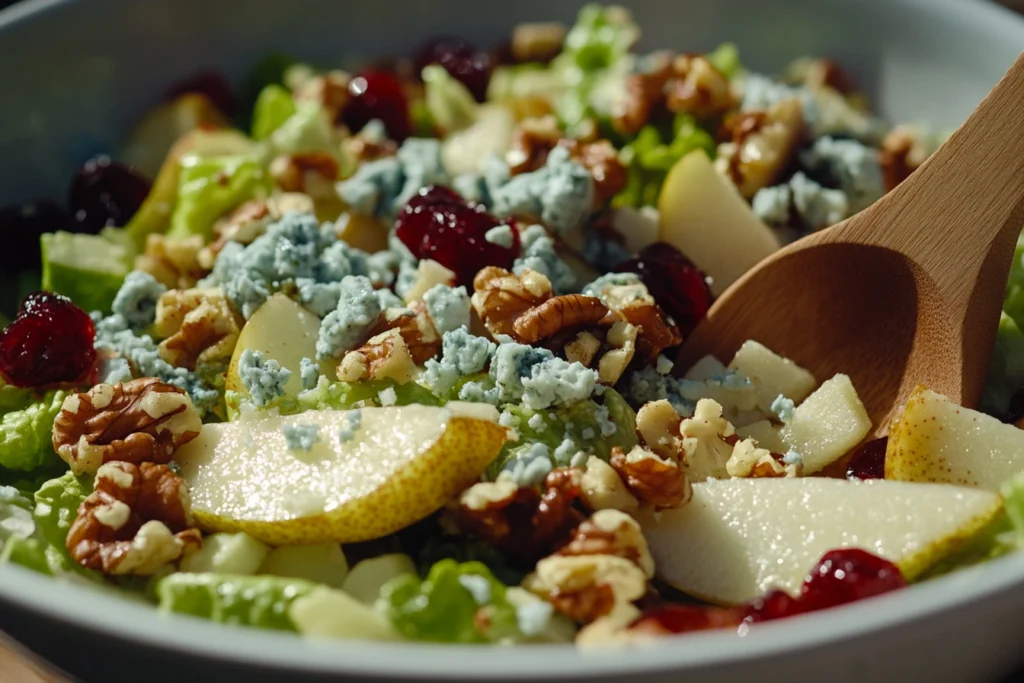1. Introduction to Blue Cheese
Blue cheese is a distinctive and flavorful cheese that stands out due to its blue veins and pungent aroma. Loved for its creamy texture and complex flavor, it has become a staple in gourmet cooking, cheese boards, and salads.
Cheesemakers use Penicillium mold to create blue cheese, giving it its signature marbling and sharp tang. Its versatility lets people crumble it over dishes, melt it into sauces, or serve it as a snack with fruits and crackers.
The goal of this article is to provide a comprehensive guide to it. From its history and types to nutritional benefits, recipes, and storage tips, you’ll discover everything you need to know about this unique cheese.
By the end, you’ll also find answers to frequently asked questions about itand how to make the most of it in your culinary creations.
2. History and Origin of Blue Cheese
2.1 Ancient Beginnings
The history of blue cheese is believed to have started as an accidental discovery. Legends suggest that early cheesemakers left fresh cheeses in caves, where natural molds began to grow, creating the distinct blue veins.
The famous Roquefort, first recorded in France, aged in limestone caves to develop its distinct flavor. These caves had the perfect conditions for developing molds that gave the cheese its unique flavor.
Other regions soon adopted this process, leading to the creation of varieties like Stilton in England and Gorgonzola in Italy.
2.2 Evolution of Production
In ancient times, artisanal methods were used to make blue cheese, relying heavily on natural molds and climatic conditions. Over time, production processes evolved, incorporating controlled environments and cultivated molds to ensure consistency.
Producers worldwide craft blue cheese using strict aging techniques to preserve its authentic texture and flavor. Regulators, especially in Europe, protect many varieties with certifications like AOC and PDO.
2.3 Famous Regions for Blue Cheese
Different regions have developed their own distinct styles of blue cheese, each offering a unique flavor profile:
- Roquefort (France): Made from sheep’s milk, it’s creamy, tangy, and rich. It is often aged in natural caves for up to 5 months.
- Stilton (England): Known for its crumbly texture and milder taste, it’s produced with cow’s milk and aged for 9 weeks.
- Gorgonzola (Italy): Available in dolce (sweet) and piccante (sharp) varieties, it’s soft, spreadable, and often used in pasta dishes.
- Danish Blue (Denmark): Creamy and slightly salty, it’s great for salads, sauces, and appetizers.
- Cabrales (Spain): A spicy, bold flavor aged in natural caves, giving it an earthy aroma.
3. Types of Blue Cheese
Blue cheese comes in several varieties, each with its own distinct flavor, texture, and origin. From creamy and mild to crumbly and sharp, there is a type of it to suit every preference and recipe.
3.1 Roquefort (France)

Roquefort is one of the oldest and most famous types of blue cheese, originating from France. Made from sheep’s milk, it is aged in limestone caves, which provide the perfect environment for mold growth.
Its flavor is tangy, slightly salty, and rich, making it ideal for salads, dressings, and spreads. Roquefort’s creamy texture also makes it an excellent choice for melting into sauces. It holds an Appellation d’Origine Contrôlée (AOC) status, protecting its traditional production methods.
3.2 Stilton (England)
Stilton is a cow’s milk blue cheese known for its crumbly texture and nutty flavor. Unlike Roquefort, it has a milder taste with earthy undertones, making it versatile for both sweet and savory dishes.
Stilton pairs well with fruits like pears and figs and is often served with honey or crackers. It is aged for nine to twelve weeks, giving it a balanced flavor that appeals to those who prefer a less pungent cheese.
3.3 Gorgonzola (Italy)
Gorgonzola is an Italian blue cheese that comes in two varieties—dolce, which is mild and creamy, and piccante, which is sharper and more crumbly. It is often used in pasta dishes, risottos, and sauces due to its smooth melting properties.
Dolce Gorgonzola is soft enough to spread on bread, while the aged piccante version is better for crumbling into salads. Its versatility makes it one of the most popular blue cheeses worldwide.
3.4 Danish Blue (Denmark)
Danish Blue, also known as Danablu, is a cow’s milk cheese with a creamy texture and a slightly salty flavor. It is milder than other blue cheeses, making it ideal for those who are new to trying the formula.
This variety is commonly used in dips, dressings, and burgers. Its smooth texture and moderate flavor allow it to blend easily with other ingredients.
3.5 Cabrales (Spain)
Cabrales is a bold and spicy blue cheese made in Spain’s Asturias region. Traditionally aged in caves, it has an intense flavor and a crumbly texture.
It pairs well with red meats, roasted vegetables, and even honey for a contrasting sweetness. Due to its strong flavor, it is often enjoyed in small quantities, making it a favorite for cheese boards and appetizers.
3.6 Other Varieties
There are several other blue cheeses, including Bleu d’Auvergne from France and Maytag Blue from the United States. Each has its own regional characteristics but shares the common mold-veined appearance and tangy flavor profile.
4. Taste and Texture of Blue Cheese
Blue cheese is widely recognized for its bold flavor and distinctive texture. Whether creamy, crumbly, or spreadable, it offers a variety of sensory experiences that make it versatile in both cooking and snacking.
4.1 Flavor Profile
Blue cheese is best known for its tangy and sharp flavor, which intensifies as it ages. Younger varieties, such as Gorgonzola dolce, tend to be mild and slightly sweet, while aged cheeses, like Roquefort and Cabrales, develop stronger and spicier notes.
The presence of Penicillium mold contributes to its earthy and slightly salty taste. Some blue cheeses also carry nutty or fruity undertones, especially when paired with honey, figs, or pears.
The flavor varies depending on the type of milk used. Sheep’s milk cheeses, such as Roquefort, have a richer and creamier taste, while cow’s milk cheeses like Stilton are milder with a nutty character.
4.2 Texture Variations
Blue cheese textures range from soft and creamy to firm and crumbly, depending on the aging process and moisture content.
Soft varieties, such as Gorgonzola dolce, are smooth and spreadable, making them perfect for dips and sauces. On the other hand, crumbly varieties, like Stilton, break apart easily and work well as toppings for salads and steaks.
Some blue cheeses also have a slightly grainy texture due to salt crystals formed during the aging process, adding to their complexity.
4.3 Aroma Characteristics
Blue cheese is famous for its pungent aroma, which is a result of the mold’s fermentation process. This strong scent often divides opinions, but it is also what makes the cheese so unique.
While some varieties have a milder smell, others, like Roquefort and Cabrales, are intensely aromatic. The earthy and tangy fragrance complements savory dishes and balances well with sweet accompaniments such as honey or dried fruits.
5. Nutritional Benefits of Blue Cheese
Blue cheese is more than just a flavorful addition to dishes; it also provides a range of essential nutrients that support overall health. From protein and calcium to probiotics, it offers a combination of benefits that make it a worthwhile addition to a balanced diet.
5.1 Macronutrients
Blue cheese is rich in protein, making it an excellent source of amino acids required for muscle growth and repair. A one-ounce serving contains approximately six grams of protein, which helps with satiety and supports tissue maintenance.
It is also a good source of healthy fats, particularly saturated fats, which provide energy and aid in the absorption of fat-soluble vitamins. However, since it is calorie-dense, portion control is recommended for those watching their caloric intake.
Blue cheese is low in carbohydrates, making it suitable for low-carb and ketogenic diets. With less than one gram of carbohydrates per serving, it fits well into weight management plans.
5.2 Vitamins and Minerals
Blue cheese provides important vitamins and minerals essential for maintaining bone strength, metabolism, and overall health.
Calcium and phosphorus, found in high amounts, are critical for bone density and teeth health. A single serving provides nearly 15% of the daily recommended intake of calcium.
Vitamin K2 supports cardiovascular health by directing calcium to bones instead of arteries. It also plays a role in proper blood clotting and bone metabolism.
Vitamin A contributes to eye health, skin repair, and immune system function.
Blue cheese also contains trace minerals such as zinc, which supports immune health, and selenium, which acts as an antioxidant.
5.3 Probiotic Content
Thanks to its fermentation process, blue cheese contains beneficial probiotics that promote gut health. These healthy bacteria aid digestion, improve nutrient absorption, and support a balanced gut microbiome. Probiotics in blue cheese may also boost immune function by reducing inflammation and enhancing gut barrier integrity. For more information, explore the benefits of probiotics for gut health.
Probiotics in it may also boost immune function by reducing inflammation and enhancing gut barrier integrity.
5.4 Dietary Considerations
Although blue cheese is nutrient-rich, it is also high in sodium due to the aging and curing process. People with high blood pressure or sodium-sensitive conditions should consume it in moderation.
People with lactose intolerance often digest blue cheese more easily because the aging process breaks down most of the lactose. However, individuals with severe dairy allergies should consult a healthcare provider before consuming it.
6. Culinary Uses of Blue Cheese
Blue cheese’s bold flavor and creamy texture make it an exceptional ingredient in both everyday meals and gourmet recipes. Its versatility means you can crumble, melt, or spread it, opening up endless culinary possibilities.
6.1 Crumbled Toppings

Cooks often crumble blue cheese over salads to add a burst of flavor and creaminess. It pairs especially well with leafy greens, nuts, and fruits like pears or apples.
Popular salad combinations include it with candied walnuts, dried cranberries, and arugula. It is also a great addition to roasted vegetables, providing a rich and savory contrast.
For protein-packed meals, sprinkle it crumbles over grilled chicken or steak for a tangy finish. It enhances flavor without the need for additional sauces.
6.2 Dips and Sauces
Blue cheese is a staple in creamy dips and salad dressings. Blended with ingredients like sour cream, yogurt, or buttermilk, it creates a rich and tangy base for dipping vegetables, wings, and chips.
Blue cheese dressing is widely used in wedge salads, Buffalo chicken dishes, and sandwiches. For a thicker consistency, simply mix crumbles into the dip without blending.
For sauces, it melts beautifully into cream-based dishes, making it ideal for pasta, risotto, and even burgers. It can also be used as a drizzle for baked potatoes or roasted cauliflower.
6.3 Melting Options
Blue cheese’s smooth melting properties make it perfect for cooking warm dishes. It blends easily into soups, casseroles, and gratins, adding a creamy texture and tangy flavor.
Popular uses include incorporating it into mac and cheese, lasagna, or even creamy polenta. Chefs often bake blue cheese into quiches or tarts to create a gourmet twist.
In sandwiches, melted blue cheese provides a rich and gooey texture, complementing meats like roast beef or turkey.
6.4 Cheese Boards and Pairings
Blue cheese shines as the centerpiece of a cheese board, offering bold flavors that pair well with sweet and savory accompaniments. For more ideas, explore other cheese pairing tips with Gruyere cheese for your next gathering.
Best pairings include honey, fig jam, or dried fruits to balance the tanginess. Nuts like walnuts and pecans add crunch, while crackers and sliced baguettes offer a neutral base.
For a light appetizer, try pairing it with fresh pears or apples. These fruits highlight the cheese’s creamy texture and bold flavor.
7. Frequently Asked Questions (FAQs)
7.1 What Makes Blue Cheese Blue?
It gets its characteristic blue veins from the mold Penicillium. Cheesemakers add this mold during production, and as the cheese ages, the mold develops into blue or green veins. These veins not only give blue cheese its signature look but also contribute to its tangy, earthy flavor.
7.2 Can You Eat Blue Cheese Raw?
Yes, people can eat blue cheese raw, often serving it crumbled on salads, spread on crackers, or paired with fruits and nuts. Its creamy and crumbly textures make it a versatile ingredient, whether eaten alone or incorporated into dishes.
7.3 Does Blue Cheese Contain Probiotics?
it is rich in probiotics due to its fermentation process. These healthy bacteria help support gut health, improve digestion, and boost immunity. Regular consumption, in moderation, can contribute to a balanced diet and overall wellness.
7.4 Is Blue Cheese Suitable for Lactose-Intolerant People?
While it does contain lactose, it is often easier to digest than fresh cheeses. The aging process reduces lactose levels, making it a better option for people with mild lactose intolerance. Those with severe dairy allergies should consult a healthcare provider before consuming it.
7.5 How Should Blue Cheese Be Stored?
To preserve its flavor and texture, wrap blue cheese in wax or parchment paper, then seal it in plastic wrap. Store it in the refrigerator at around 40°F (4°C). For longer storage, freeze it, but note that freezing may slightly alter its texture.
8. Conclusion
Blue cheese is a versatile and flavorful addition to any kitchen, offering a rich history, distinct taste, and numerous culinary applications. Whether you enjoy it crumbled on salads, melted into sauces, or served on a cheese board with fruits and nuts, it brings bold flavor and texture to any dish.
Beyond its taste, it provides valuable nutrients like protein, calcium, and probiotics, supporting bone health, digestion, and immunity. Its wide range of varieties, from creamy Gorgonzola to crumbly Stilton, ensures there’s a blue cheese for every palate.
With proper storage techniques and serving tips, you can enjoy it at its freshest. Whether you’re new to this unique cheese or a long-time fan, it’s a must-try ingredient for those looking to add depth and character to their recipes.
